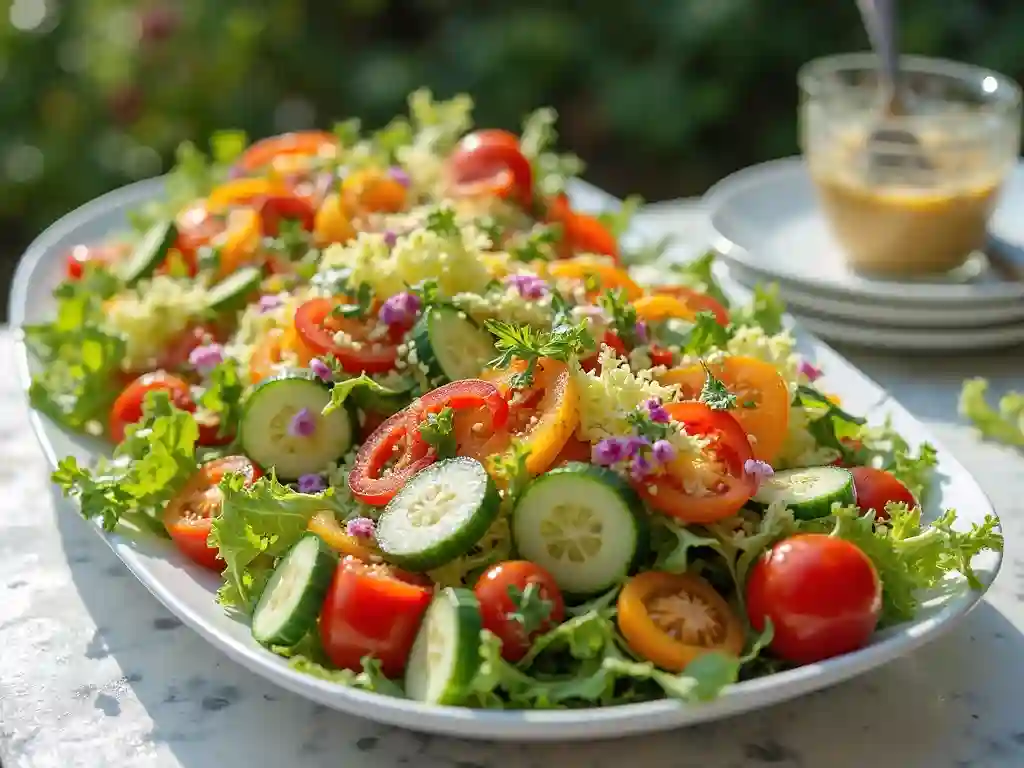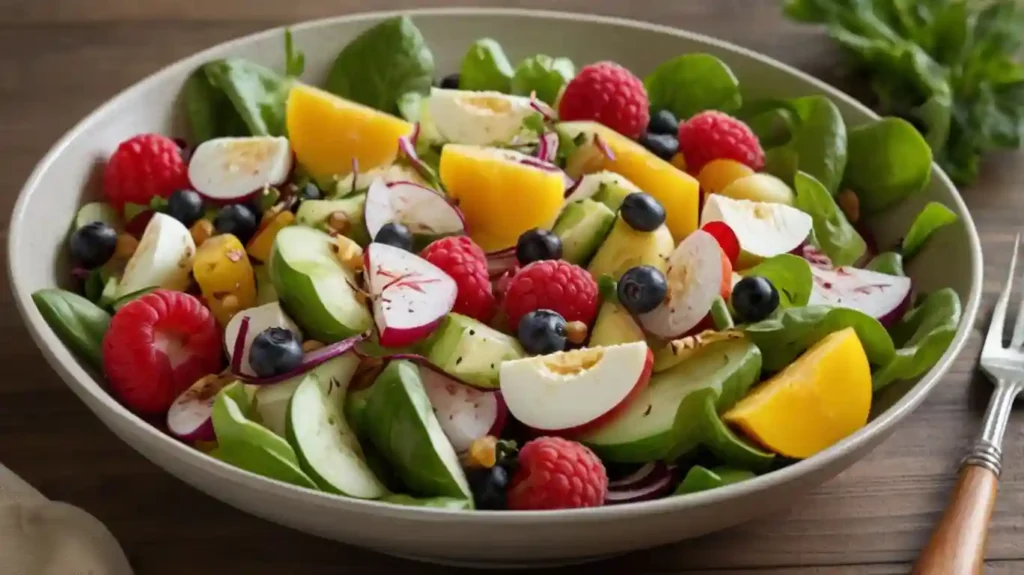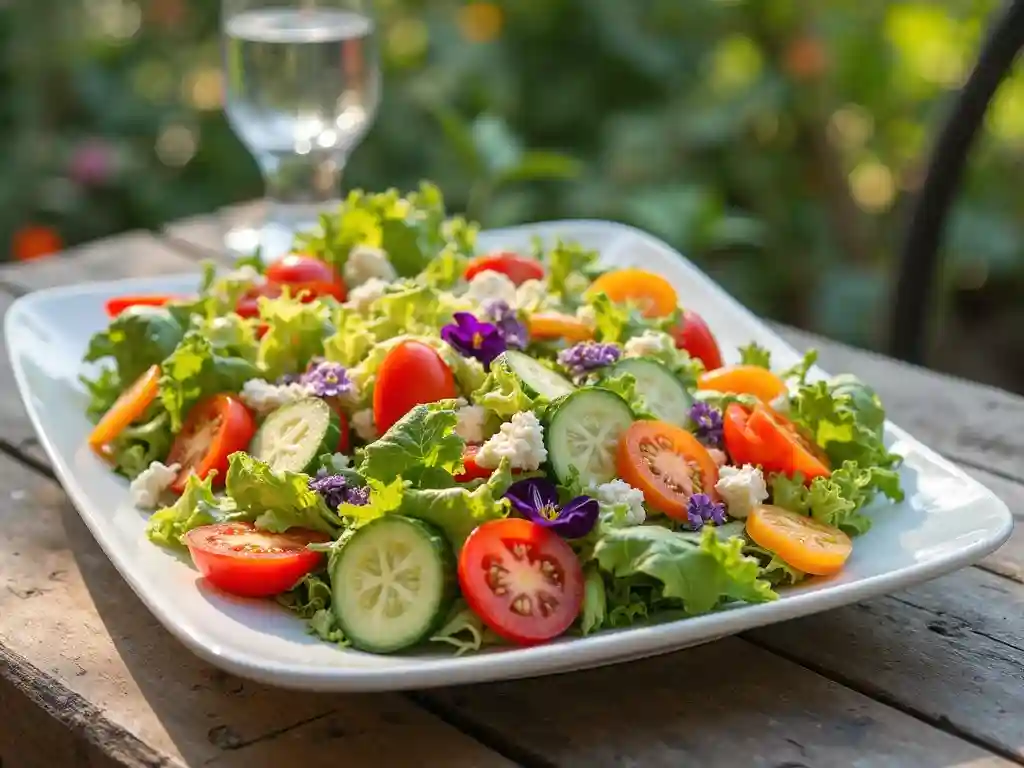The Irresistible Appeal of Summer Salads
Summer brings with it long days, radiant sunshine, and the undeniable craving for light, crisp meals that fuel without weighing you down. Enter summer salads—vibrant, colorful creations bursting with juicy produce, bold textures, and refreshing flavors.
These salads aren’t just pretty to look at. They’re often nutritional goldmines, full of antioxidants, fiber, and essential vitamins. Whether you’re planning a backyard BBQ, hosting a sunny brunch, or just need something light after a day at the beach, summer salads hit the spot every time.
Many recipes come together in under 30 minutes, making them ideal for busy weeknights or impromptu gatherings. And with many naturally gluten-free, vegetarian, or vegan options, there’s a recipe for every preference and diet.
Essential Ingredients for Vibrant Summer Salads
Creating a summer salad that bursts with flavor, texture, and visual appeal starts with choosing the right ingredients. From sun-ripened fruits to crunchy add-ins, these essential elements bring your salad to life and make it the star of any summer table.
Peak Seasonal Produce: The Colorful Foundation of Every Great Salad
The foundation of any memorable salad is its produce — and in summer, nature offers a stunning palette. Fresh, seasonal fruits and vegetables provide the juiciness, crispness, and sweetness that make summer salads truly shine.

Top Picks for Fruits
Each of these fruits brings its own unique sweetness and texture:
- Peaches & Nectarines: Juicy, floral, and slightly tart — amazing when grilled or paired with burrata.
- Watermelon & Cantaloupe: Hydrating and refreshing, especially when cubed with feta and mint.
- Strawberries & Blueberries: Bright and sweet — ideal for spinach or arugula-based salads.
- Mango & Kiwi: Add a tropical twist and a vibrant pop of color.
- Grapes & Raspberries: Juicy bursts that complement savory ingredients like goat cheese or nuts.
Top Picks for Vegetables
Balance the sweetness of fruit with the crisp, earthy freshness of summer veggies:
- Corn (Grilled or Raw): Adds a smoky sweetness and beautiful golden color.
- Cherry or Heirloom Tomatoes: Juicy and acidic, ideal for caprese-style salads.
- Cucumbers (Persian or Lebanese): Crunchy, cooling, and perfect for any base.
- Leafy Greens (Arugula, Baby Spinach, Romaine): Form the bulk of your salad — choose a mix for variety in flavor and texture.
Pro Tip: Visit your local farmer’s market for produce picked at peak ripeness — the flavor difference is unmistakable.
Aromatic Fresh Herbs: The Flavor Boosters
Herbs aren’t just garnish — they’re flavor powerhouses. A small handful of the right fresh herbs can completely transform your salad, adding aroma, brightness, and complexity.
Must-Have Herbs and How to Use Them
- Mint: Cooling and sweet; amazing with melons, peas, or citrus-based dressings.
- Basil: Sweet and slightly peppery; pairs wonderfully with tomatoes, peaches, or mozzarella.
- Cilantro: Zesty and citrusy; perfect in Mexican or Thai-inspired salads with lime vinaigrette.
- Parsley (Flat-leaf): Clean and herbaceous; adds balance and a hint of bitterness to richer ingredients like tahini or feta.
Flavor Layering Tip: Mix two or more herbs for a deeper, more nuanced flavor. Try basil + mint for a Mediterranean vibe or cilantro + parsley for a Middle Eastern touch.
Crunch and Texture Elements: The Game Changers
Texture is what turns a good salad into an unforgettable one. It keeps every bite interesting, adds contrast, and makes the salad feel heartier and more satisfying.
Crunchy Additions You’ll Crave
- Toasted Seeds: Pumpkin (pepitas) or sunflower seeds add a nutty crunch and are rich in healthy fats.
- Chopped Nuts: Almonds, pistachios, or pecans bring bite and buttery richness — toast them lightly to intensify flavor.
- Crispy Breads: Think homemade croutons, torn and toasted sourdough, or pita chips tossed with olive oil and garlic.
Balance is Key: Combine soft and crisp textures — like creamy avocado with crispy croutons — for a mouthwatering contrast in every forkful.

Crafting Flavorful Dressings
A great salad dressing doesn’t just add flavor—it brings all the ingredients together into one harmonious bite. From sweet-tart vinaigrettes to rich, creamy blends and globally inspired options, the right dressing can elevate a simple bowl of greens into a memorable meal. Let’s explore the art of creating delicious, balanced dressings that suit every taste and occasion.
Sweet and Tangy Combinations
Sweet and tangy dressings offer brightness and balance, making them perfect for fruit-forward or summer salads.
Honey-lime vinaigrette, for example, is a vibrant blend of citrusy zest and natural sweetness. It’s ideal for salads featuring fresh mango, strawberries, or grilled pineapple. The acidic lime juice not only enhances flavor but also helps slow oxidation—keeping fruits like apples and pears looking fresh and appetizing.
Add a pinch of chili flakes or minced ginger for a little heat to contrast the sweetness.
Try it with:
- Spinach, strawberry & almond salad
- Grilled chicken and mango salad
- Pear, walnut, and goat cheese salad
Creamy and Rich Options
Creamy dressings deliver luxurious texture and mouthfeel without always relying on dairy. A spicy cashew dressing, for example, is a plant-based option that’s both rich and nutritious. Made with soaked cashews, fresh lime juice, maple syrup, garlic, apple cider vinegar, and a dash of hot sauce, it’s incredibly versatile.
Its slightly nutty, tangy, and spicy profile pairs beautifully with heartier ingredients like roasted vegetables, quinoa, or sweet potatoes.
Try it with:
- Roasted sweet potato and kale salad
- Grain bowls with chickpeas and avocado
- Warm lentil and broccoli salad
Global-Inspired Flavors
Why not bring international flair to your salad bowl? Dressings inspired by global cuisines can open up exciting new flavor combinations. One standout is pomegranate molasses dressing—deeply tangy with a touch of sweetness. This Middle Eastern staple works wonderfully with fresh herbs, nuts, and tangy cheeses.
Mix it with olive oil, a bit of Dijon mustard, and crushed garlic for a punchy, aromatic dressing that complements bold and earthy ingredients.
Try it with:
- Persian cucumber and tomato salad
- Bulgur wheat and mint tabbouleh
- Grilled eggplant with feta and parsley
Simple and Zesty
Sometimes, less is more. A basic combination of extra-virgin olive oil and lemon juice brings out the natural flavors of vegetables and legumes without overpowering them. This light, zesty pairing is a staple in Mediterranean and Middle Eastern cuisines—perfect for salads that celebrate fresh herbs, tomatoes, and crispy pita.
It’s also the go-to choice when you’re working with seasonal produce and want to let the ingredients shine.
Try it with:
- Classic chickpea and cucumber salad
- Fattoush with crispy pita and sumac
- Arugula, cherry tomato, and Parmesan salad
Transforming Salads into Satisfying Meals
Gone are the days when salads were just sad side dishes or rabbit food. With the right ingredients and a little imagination, salads can be transformed into hearty, delicious meals that satisfy your hunger and nourish your body. It all comes down to smart layering, balance, and flavor—without sacrificing freshness. Here’s how to level up your salads and turn them into main-course stars.
Adding Hearty Proteins
One of the easiest ways to make a salad more filling is to add a protein source. Whether you’re eating plant-based or enjoy dairy and legumes, the right proteins give your salad staying power.
Plant-Based Protein Boosters
Adding plant-based proteins brings fiber, nutrients, and flavor. Here are some winning options:
- Seared Halloumi or Feta Crumbles: These cheeses add richness and a salty punch. Halloumi can be grilled or pan-fried until golden brown, adding a chewy, satisfying texture.
- Chickpeas or Lentils: Roasted or simply tossed in olive oil and spices, these legumes are budget-friendly and protein-packed.
- Grilled Tempeh or Crispy Tofu Bites: Marinate for extra flavor, then bake or sauté until golden. These are perfect for vegan and vegetarian salads.
Drawing on Global Cuisines
Global flavors can transform a basic salad into an exciting culinary journey. Take inspiration from different food cultures to bring bold spices, vibrant textures, and unique ingredients to your salad bowl.
🇱🇧 Lebanese Fattoush
A crunchy, tangy salad made with toasted pita bread, fresh cucumbers, tomatoes, and a generous sprinkle of sumac. Mint and parsley add herbal depth, while lemon juice gives it a refreshing kick. It’s perfect for hot summer days.
🇬🇷 Greek Chickpea Salad
This Mediterranean classic includes chickpeas, feta cheese, Kalamata olives, diced tomatoes, cucumber, and red onions, all tied together with oregano and olive oil. It’s savory, briny, and super satisfying.
🇮🇷 Persian Pomegranate Salad
This salad offers a balance of sweet and savory. Think pomegranate seeds, fresh herbs like mint and parsley, crunchy cucumbers, and toasted walnuts. Often dressed with a splash of lime and olive oil, it’s bright, aromatic, and perfect for entertaining.
Versatile Serving Ideas
Salads aren’t one-dimensional. With a few tweaks, they can be adapted to all sorts of meals and occasions. Here’s how to get creative with your serving styles:
Stuff into Pita Pockets
Use hearty salads like Greek chickpea or falafel-based mixes and tuck them into warm pita for a handheld meal. Add a drizzle of yogurt sauce or hummus for extra flavor.
Serve as Part of a Mezze Board
Combine several salads—tabbouleh, hummus, baba ghanoush, marinated olives—and serve with flatbreads and grilled veggies. This is a great way to host or entertain while keeping things fresh and light.
Spoon Over Grains for a Buddha Bowl Vibe
Layer your salad over a base of warm quinoa, farro, brown rice, or couscous. Add a handful of greens, roasted vegetables, and a punchy dressing. It becomes a complete, nutrient-dense meal in a bowl.
Try This Combo:
- Base: Brown rice
- Salad: Spicy chickpea cucumber salad
- Topper: Roasted sweet potato cubes + tahini drizzle
- Garnish: Pickled onions & toasted seeds
Expert Tips for Your Best Summer Salads
Make your summer salads not just good—but unforgettable. Here’s how to master every stage of salad preparation, from shopping smart to storing leftovers. These expert tips will elevate your salad game to restaurant-quality results at home.
Optimal Ingredient Selection: Choose the Freshest, Flavor-Packed Produce
The key to a stellar salad is fresh, ripe ingredients. But knowing what to pick—and when—makes all the difference.
✅ Timing Is Everything
Some fruits like mangoes, kiwis, and avocados need a few days to fully ripen. Plan ahead when shopping, especially if you’re preparing a salad for a weekend gathering or barbecue. On the flip side, peaches and nectarines ripen—and spoil—quickly. Check for slight softness and a fragrant smell before buying. Overripe fruit can turn your salad mushy in hours.
✅ Taste-Test Before You Toss
Not all fruits and veggies taste the same—even from the same batch. Always taste a slice of melon, cucumber, or tomato before adding it to your bowl. This quick step ensures you’re building a salad with balanced flavor, not bitterness or blandness.
✅ Mix Textures and Colors
Great salads are a feast for the eyes and the palate. Combine crunchy cucumbers, creamy avocados, juicy tomatoes, and crisp greens. Include a mix of colors like purple cabbage, yellow bell peppers, and red strawberries for visual appeal and added nutrients.
Preparation Nuances: Little Techniques, Big Flavor Impact
Small details in the prep process can completely change your salad’s texture and taste.
Dry Your Greens Thoroughly
Excess water from rinsing lettuce or spinach is the enemy of a great salad. It dilutes dressings and makes greens soggy. Use a salad spinner or gently pat leaves dry with paper towels before assembling.
Cool Your Corn the Right Way
If you’re using freshly boiled or grilled corn, let it cool completely before slicing off the kernels. Warm corn releases steam, which can wilt nearby ingredients and water down your dressing.
Dress with Care—Timing Matters
Don’t toss your salad with dressing until the very last minute, especially if it’s vinaigrette-based. Early dressing can make greens limp. For hearty grains or pasta salads, however, letting them soak up the dressing for a while can boost flavor.
Smart Storage and Make-Ahead Hacks: Keep It Fresh, Not Sad
Planning ahead? These storage tips ensure your salad stays vibrant and crisp for hours—or even days.
Store Delicate Ingredients Separately
Items like avocados, peaches, and soft cheeses should be added just before serving. They bruise easily and can brown or weep moisture if pre-mixed.
Keep Dressing on the Side
If you’re meal prepping or packing lunch, store the dressing in a separate container. This prevents sogginess and lets each bite stay fresh until it’s time to eat.
Use Airtight, Layered Containers
Layer sturdier ingredients like beans, grains, or chopped carrots at the bottom. Place leafy greens and herbs at the top. Use airtight containers or mason jars to seal in freshness and prevent odors from leaking.
Dietary Adaptability: Customize for Any Lifestyle or Allergy
Summer salads can suit nearly every dietary plan—you just need to know how to adjust them.
Make It Allergy-Friendly
Allergic to nuts or dairy? Use toasted sunflower seeds or roasted chickpeas for crunch instead of almonds. Swap cheese with dairy-free alternatives or nutritional yeast for umami.
Add Protein for a Complete Meal
Make salads more filling by adding grilled chicken, tuna, tofu, hard-boiled eggs, or quinoa. This keeps energy levels stable and transforms a side salad into a satisfying main dish.
Keep It Gluten-Free Without Sacrificing Crunch
Replace traditional croutons with roasted pumpkin seeds, crispy lentils, or gluten-free granola. These options add texture without triggering sensitivities.
Cater to Keto or Vegan Diets
For keto-friendly salads, go heavy on healthy fats like avocado, olive oil, and seeds, and skip high-carb toppings like corn or sweet dressings. For vegan versions, use plant-based proteins like tempeh, edamame, or hummus and avoid animal-based cheeses or dressings.
Conclusion
Summer salads are a canvas of color, nutrition, and flavor. Whether you’re leaning into tradition or exploring new global twists, there’s no end to what you can create. With the right ingredients, a bit of creativity, and these expert tips, your next summer dish is bound to shine.
Frequently Asked Questions (FAQs)
1. What fruits go best in a summer salad?
Watermelon, peaches, strawberries, mangoes, and blueberries are all excellent. Their sweetness pairs well with herbs and tangy dressings.
2. Can summer salads be made ahead of time?
Yes, but keep dressings and delicate ingredients separate until serving to maintain texture and flavor.
3. What protein can I add to make a salad more filling?
Chickpeas, grilled tofu, halloumi, or lentils are great plant-based options. You can also use hard-boiled eggs or lean meats.
4. Are summer salads healthy?
Absolutely! They’re packed with fiber, antioxidants, and hydration, especially when loaded with fresh fruits and vegetables.
5. How do I keep my salad from getting soggy?
Dry ingredients thoroughly, add dressing right before serving, and avoid overripe or mushy produce.
6. What dressing works best with fruit-based salads?
Sweet-tangy vinaigrettes like honey-lime or citrus-balsamic dressings complement fruit without overpowering it.

